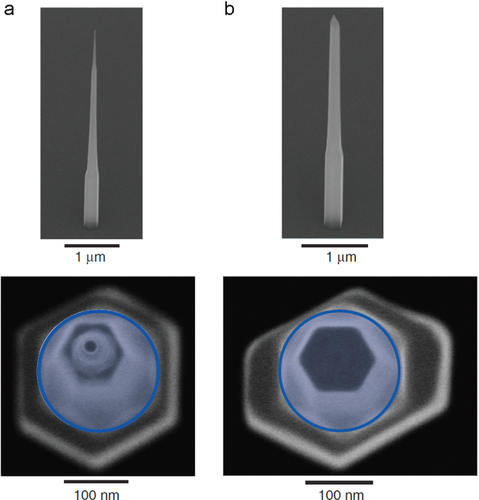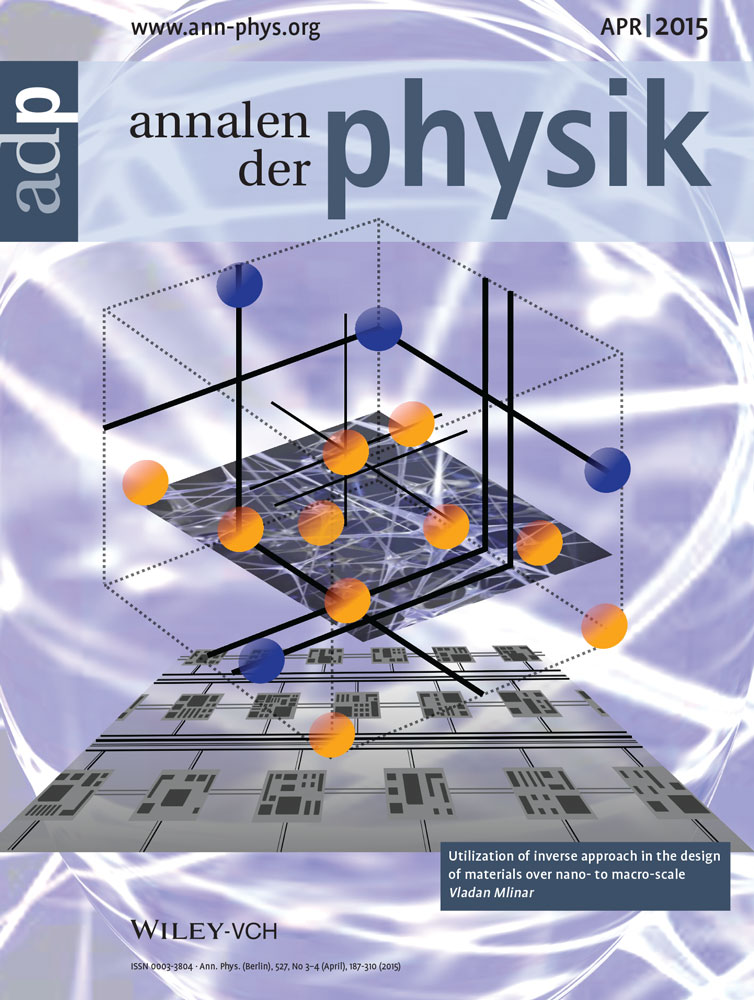Nanowires entangled photons can advance integrated quantum photonic circuits
The results reported by Versteegh et al. 1 and Huber et al. 2 certainly constitute a step forward in pursuing quantum communication technology towards future larger scalability in arrays of sources. They realised bright entangled photon sources in the spectral region of ∼935 nm and ∼913 nm, respectively, that combine high-fidelity entanglement, on-demand generation, high extraction efficiency, directional and coherent emission, as well as position control at the nano-scale. These properties are now achieved in single devices.
In 1909 Guglielmo Marconi shared with Carl Ferdinand Brown the Nobel Prize in physics in recognition of their contribution to the development of wireless telegraphy, setting the start of long distance radio transmission based on discrete signal. Marconi then developed with others the radio transmission to a commercial success.
Less than a century later, Bennett et al. 3 proposed to transmit not only bits but also additional information to communicate and transfer the inherent property of a quantum physical system interconnected with a sender and a receiver. According to Bennett 3 “An unknown quantum state ϕ can be disassembled into, then later reconstructed from, purely classical information and purely non-classical Einstein-Podolsky-Rosen (EPR) correlations. To do so the sender, Alice, and the receiver, Bob, must prearrange the sharing of an EPR-correlated pair of particles. Alice makes a joint measurement on her EPR particle and the unknown quantum system, and sends Bob the classical result of this measurement. Knowing this, Bob can convert the state of his EPR particle into an exact replica of the unknown state ϕ which Alice destroyed.”
The work by Bennett et al. 3 immediately received huge interest 4. It set the basis of the last 20 years of a research endeavour known as quantum communication. Significant work has been carried out to prove the feasibility of this idea and now more practical solutions have been made available, as demonstrated by the emergence of recent quantum technologies.
Quantum communication is strongly relying on transmission of both classical bits and quantum bit or qubits. “Classical” bits are units of information represented as zero or one, true or false. Qubits are superposition of zero and one states and can encode quantum information. Quantum teleportation provides a mechanism of transferring a qubit from one location to another relying on the quantum superposition of, for example, strongly correlated photons states, which allow by measuring one photon of the pair to simultaneously know the state of the sibling photon. This translates in a transfer of information without the limitation associated of the actual physical qubit transportation. In fact, the transfer of qubits requires that an entangled quantum state is created and the two parts of this state are shared between two locations. Teleportation requires that a quantum channel is established between the source and the destination (Alice and Bob) and a classical information link is used to transmit two classical bits with each qubit. Classical bits can only be transmitted slower than the speed of light. Conversely, quantum correlations may occur instantaneously.
The quantum states of single atoms, photons and solid state qubits have been teleported so far (Bouwmeester et al. 5; Gottesman & Chuang 6; Riebe et al. 7; Chen et al. 8; Krauter et al. 9 just to name a few). Photons are regarded as the most robust source of entangled quantum states due to their weak interaction with the environment, therefore they have a long coherence time as opposite to solid state qubits.
Quantum communication protocols like quantum teleportation and quantum repeaters require entangled states. These states have been practically achieved in bulk optical systems based on nonlinear optics effects in birefringent crystals since many years now (Ou & Mandel 10). These sources are not deterministic as they rely on the random decay of one higher energy pump photon in two photons by spontaneous parametric down-conversion. Also they are not ideal for integration in nanophotonics circuits and have limited scalability to achieve large numbers of quantum gates or quantum networks. Artificial atoms, like quantum dots (QDs), on the other hand constitute a deterministic source of single or entangled photon states.
A QD is made of a semiconductor of lower band gap embedded in a semiconductor of higher band gap. The band gap offsets results in a three dimensional electronic confinement. An electron may then be excited optically or electrically to the conduction band, leaving a hole in the valence band. An exciton state may be formed by these electron–hole pairs trapped by the QD. Further excitation of the QD may lead to a biexciton state with two electrons and two holes. The radiative decay of the exciton leads to the emission of one photon. The biexciton-exciton radiative cascade results in the emission of two photons. The photons are not re-emitted until the exciton or biexciton are excited again. This delivers a determinist photon emission.
Owing to asymmetries in the QD, there is actually a fine structure splitting (FSS) in the exciton state due to the different electron and hole spin states of the QD, leading to slightly different transition frequencies for the two photons generated with horizontal and vertical polarization. This requires temporal post selection of the emitting photons to create a perfect entangled photons state, limiting the efficiency of QDs for entanglement generation (loss of photons) and therefore their practical use in quantum communication protocols.
Versteegh et al. 1 and Huber et al. 2 grew semiconductor QDs embedded in [111]-oriented tapered nanowire waveguides grown in the wurtzite phase, specifically InP nanowires containing single InAsP; the synthesis methods are slightly different, in Versteegh et al. 1 thicker QDs are grown (diameter ∼25-30 nm). Although theoretically previously predicted, entanglement was not yet been demonstrated for a nanowire QD. Versteegh et al. 1 demonstrate a bright and coherent source of strongly entangled photon pairs from a position controlled nanowire QD with a fidelity as high as 0.859 ± 0.006 and concurrence of 0.80 ± 0.02 with a FSS value of 1.2 μeV, deduced from the polarization-dependence measurement of the energy emission difference from the exciton and biexcition states.
There are two main advantage in a nanowire embedded QD for photon pairs generation: the high refractive index of the nanowire allows guiding the light originated from the QD and the tapered end allows an efficient light extraction with broad spectral operation; in QD embedded in nanowires grown along [111] direction, the FSS should vanish, thus providing a nearly ideal entanglement via biexcition-exciton radiative cascade decay without the need of any post-selection.
In Versteegh et al. 1 the created two-photon quantum states provide different photon cross-correlation from what observed previously from QDs, revealing that the two-photon quantum state from the nanowire is closer to (|HV> + |VH>)/ than to the commonly measured state (|HH> + |VV>)/
than to the commonly measured state (|HH> + |VV>)/ . The entangled photon states produced are modified by the nanowire shape and small anisotropy, justifying different photons states compared to the ones measured in QDs. The photons pairs produced by the QDs experience a variation of their polarization due to birefringence while propagating along the nanowire.
. The entangled photon states produced are modified by the nanowire shape and small anisotropy, justifying different photons states compared to the ones measured in QDs. The photons pairs produced by the QDs experience a variation of their polarization due to birefringence while propagating along the nanowire.
Figure 1 shows SEM image of (a) symmetric and (b) asymmetric nanowires. The nanowire elongation in (b) is an extreme example that leads to geometric birefringence responsible for the rotation of the quantum state originated from the QDs.

In Huber et al. 2 a FSS value of 18 μeV was determined, possibly responsible for a lower fidelity of the generated entangled states. In this case they did not observe evident sign of lateral elongation in scanning electron microscopy images showing the cross-section of the hexagonal nanowires cores, a small elongation ratio was confirmed unable to induce a significant level of FSS as the one observed. By inspecting the cross-section of the nanowires dislocation of the QD insertion with respect to the nanowire axis was observed. Wave function calculations of the electrons and holes for on and off-centred QDs show that off-centred QDs exhibit orbitals with lower symmetry (C2v) compared to centred QDs (C3v). This lower symmetry can be responsible only in minor percentage for the FSS. The authors conclude that the large FSS observed can be attributed to the compositional anisotropy rather than the geometrical asymmetry.
This new nano-scale entangled photon source can be integrated at desired positions in a quantum photonic circuit, single-electron devices and light-emitting diodes, allowing producing arrays of such sources on a chip. A further step may certainly be identified in having an electrically rather than as optical pump of the entangled photon pairs in the nanowire. Also photons extraction efficiency of 90% is predicted by redesigning the nanowires. Some work needs still to be done however to surpass the present sources based on spontaneous parametric down-conversion. The nanowire photon states entanglement fidelity is not as high as conventional sources and the single-photon coherence of the emitted photon pairs is not yet Fourier-transform limited. By developing a thermal annealing process to get rid of the compositional inhomogeneity in the nanowires a decrease of the FSS to sub-μeV level for any desired target wavelength could be achieved. By two-photon resonant excitation techniques, cooling of the quantum dot sample to 300mK and Purcell effect radiative decay enhancement, photons indistinguashibility could be achieved and possibly surpass in the future conventional sources.




